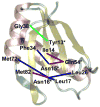Do collective atomic fluctuations account for cooperative effects? Molecular dynamics studies of the U1A-RNA complex
- PMID: 16834346
- PMCID: PMC2603296
- DOI: 10.1021/ja0606071
Do collective atomic fluctuations account for cooperative effects? Molecular dynamics studies of the U1A-RNA complex
Abstract
A complete understanding of gene expression relies on a comprehensive understanding of the protein-RNA recognition process. However, the study of protein-RNA recognition is complicated by many factors that contribute to both binding affinity and specificity, including structure, energetics, dynamical motions, and cooperative interactions. Several recent studies have suggested that energetic coupling between residues contributes to formation of the complex between the U1A protein and stem loop 2 of U1 snRNA as a consequence of a cooperative network of interactions. We have performed molecular dynamics simulations on the U1A-RNA complex, including explicit water and counterions, and analyzed the results based on the calculated positional cross-correlations of atomic fluctuations. The results indicate that cross-correlations calculated on a per residue basis agree well with the observed inter-residue cooperativity and predict that the networks identified to date may also be coupled into an extensive hyper-network that reflects the intrinsic rigidity of the RNA recognition motif. In addition, we report a comparison of the MD calculated correlations with the results of a positional covariance analysis based on the sequences of 330 RNA recognition motifs, including U1A. The calculated inter-residue cross-correlations agree very well with the results of the sites exhibiting positional covariance. Collectively, these results strongly support the hypothesis that collective fluctuations contribute to cooperativity and the corresponding observed thermodynamic coupling. Predictions of additional sites in U1A that may be involved in cooperative networks are advanced.
Figures


Similar articles
-
A study of collective atomic fluctuations and cooperativity in the U1A-RNA complex based on molecular dynamics simulations.J Struct Biol. 2007 Mar;157(3):500-13. doi: 10.1016/j.jsb.2006.10.022. Epub 2006 Nov 10. J Struct Biol. 2007. PMID: 17194603 Free PMC article.
-
Investigation of a conserved stacking interaction in target site recognition by the U1A protein.Nucleic Acids Res. 2002 Jan 15;30(2):550-8. doi: 10.1093/nar/30.2.550. Nucleic Acids Res. 2002. PMID: 11788718 Free PMC article.
-
Molecular dynamics and thermodynamics of protein-RNA interactions: mutation of a conserved aromatic residue modifies stacking interactions and structural adaptation in the U1A-stem loop 2 RNA complex.J Am Chem Soc. 2001 Mar 21;123(11):2548-51. doi: 10.1021/ja005538j. J Am Chem Soc. 2001. PMID: 11456923
-
Use of the spliceosomal protein U1A to facilitate crystallization and structure determination of complex RNAs.Methods. 2010 Oct;52(2):159-67. doi: 10.1016/j.ymeth.2010.06.008. Epub 2010 Jun 8. Methods. 2010. PMID: 20554048 Free PMC article. Review.
-
RNA-protein interactions. Diverse modes of recognition.Curr Biol. 1995 Mar 1;5(3):249-51. doi: 10.1016/s0960-9822(95)00051-0. Curr Biol. 1995. PMID: 7540101 Review.
Cited by
-
High Energy Channeling and Malleable Transition States: Molecular Dynamics Simulations and Free Energy Landscapes for the Thermal Unfolding of Protein U1A and 13 Mutants.Biomolecules. 2022 Jul 4;12(7):940. doi: 10.3390/biom12070940. Biomolecules. 2022. PMID: 35883496 Free PMC article.
-
Molecular dynamics simulation study of the binding of purine bases to the aptamer domain of the guanine sensing riboswitch.Nucleic Acids Res. 2009 Aug;37(14):4774-86. doi: 10.1093/nar/gkp486. Epub 2009 Jun 10. Nucleic Acids Res. 2009. PMID: 19515936 Free PMC article.
-
Conserved residues of the Pro103-Arg115 loop are involved in triggering the allosteric response of the Escherichia coli ADP-glucose pyrophosphorylase.Protein Sci. 2015 May;24(5):714-28. doi: 10.1002/pro.2644. Epub 2015 Mar 12. Protein Sci. 2015. PMID: 25620658 Free PMC article.
-
Mechanism of mRNA-STAR domain interaction: Molecular dynamics simulations of Mammalian Quaking STAR protein.Sci Rep. 2017 Oct 3;7(1):12567. doi: 10.1038/s41598-017-12930-2. Sci Rep. 2017. PMID: 28974714 Free PMC article.
-
Characterization of the dynamics of an essential helix in the U1A protein by time-resolved fluorescence measurements.J Phys Chem B. 2008 May 15;112(19):6122-30. doi: 10.1021/jp076896c. Epub 2008 Feb 23. J Phys Chem B. 2008. PMID: 18293956 Free PMC article.
References
Publication types
MeSH terms
Substances
Grants and funding
LinkOut - more resources
Full Text Sources

